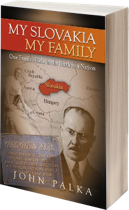Escapes from Nazis and Communists; acts of heroism during World War II; the lives of ordinary men and women as well as of leaders who helped shape the Slovak nation itself—these are some of the narrative threads of My Slovakia, My Family.
Part I begins in Czechoslovakia just before World War II breaks out, when my mother escapes from the Nazis two weeks before my birth in Paris. A year and a half later, with the war raging, our family narrowly avoids the concentration camps and manages to reach safety in the United States. We return to Czechoslovakia after the war but are forced all too soon to escape to freedom once again, this time under the barbed wire of the Iron Curtain. We settle as immigrants in the United States while the numbing weight of Communism bears down on the wider family we left behind. Years after my parents die, I learn of family stories of heroism during the war and, especially, of the contributions of my own father, which I never knew of until I traced the source of a handful of photographs in a family album.
Part II is about the more distant past. Within the overarching story of Slovakia’s becoming a nation are the stories of three visionaries: my two grandfathers, Milan Hodža and Ján Pálka—whose lives and work during the era of Czechoslovakia embodied national and social ideals that still resonate today—and my great-granduncle Michal Miloslav Hodža, who played a pivotal role in the revolution of 1848, the formulation of Slovak as a literary language, and the whole Slovak National Awakening of the mid 19th century.
The Hodža men and women, four generations of them, contributed significantly to building both a nation and a culture—to conceiving and defending the idea that Slovaks have a distinctive identity, strongly linked to language, and that it is right to struggle against deliberate attempts to destroy that identity. This struggle began while Slovaks lived in the Kingdom of Hungary and saw its resolution in the building of new states, first Czechoslovakia and later today’s independent Slovakia. Generations of Pálkas, who rose from significant roles in the great craft guilds of the past to positions of wealth and influence, supported this struggle personally and financially.
Part III returns to the present day. Since the fall of Communism, I have visited Slovakia often, and I relish the close family contacts, new friendships, echoes of the past, and hopes for the future that I have found there. Through the stories I narrate, I offer glimpses of what Slovakia means to me today.
Slovak Edition:
My Slovakia, My Family was first published in Slovakia under the title Moje Slovensko, moja rodina (Kalligram, Bratislava, 2010). This Slovak language edition is now sold out, but I have a few copies available for sale. If you are interested, please contact me.
